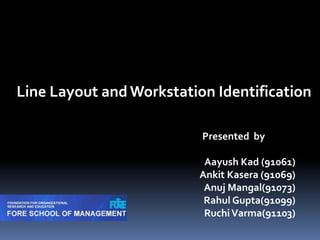
Line Layout and Workstation Identification
- 1. Line Layout and Workstation Identification Presented by AayushKad (91061) AnkitKasera (91069) AnujMangal(91073) Rahul Gupta(91099) RuchiVarma(91103)
- 2. MRP Assumes infinite capacity in the manufacturing process/department. Orders are periodically issued as per master schedule. Uses Bill of Materials to get dependency in demand.
- 3. Imbalance in Line Additional orders often requested. Release orders in advance. Causes shortages leading to expediting activities. Late orders or overtime. Increased Inventory as buffer.
- 4. Lean Manufacturing Little or no type of muda (waste) Differentiate between Value adding and Non value adding steps
- 7. Pull based production system.
- 8. All resources located at one place.
- 9. Eliminate the need for batching or grouping the resources.
- 11. Steps to implement Calculate Resource Requirements Defining Resource Attributes Physical layout of resources Maintaining workstation balance
- 12. 1. Calculating Resource Requirements # Resources = Standard Time SOE/Takt Numerator Sum of all labor and machine categories of work individually. Includes non value adding time like dynamic setups. Denominator Takt= Work minutes per shift * No. of shifts Throughput volume per day
- 13. Sequence of Events (Labor) ∑ All Times = 8.05
- 14. Multi Product Line When one process used for producing more than one product we use a weighted standard time as follows: Standard Time Weighted (STW) = ∑Vc*SOE Standard Time/∑Vc
- 15. STW=3585/130 = 27.6 minutes Takt Time= 7 hours x 60 minutes x 1 shift = 420 =3.23 minutes Total Process F Volume 130 Resources = 27.6/3.23=9 approx
- 16. 2. Defining Resources Define physical attributes of individual resources. SOE labor time results in number of people required. The number of resources calculated for future must be in proportion to current resources and volume.
- 17. 2. Defining Resources Physical location from which work to be performed must also be defined including space for supporting equipment. Thus, number of physical workstations also determined. For each workstation, its attributes and dimensions on the shop floor must be defined. Reduce excess workstation space.
- 18. Balancing a Machine to Takt Time Build additional inventory equal to: Cycle Time of Machine = Units of Inventory Process Takt Time Eg: A machine process requires 60 minutes to travel the conveyer length in a tunnel and Takt time is 3.23 minutes. Inventory = 60/3.23=19 units. Additional 19 hooks will be added and spaced such that each unit takes 60 minutes on conveyer and exit tunnel every 3.23 minutes.
- 19. 3. Physical Layout of Resources Reduce Move and Wait time. Use paper simulation as it involves: Team Participation Low Cost Work upstream. Leave space for material movement. Keep environment and safety needs in mind.
- 20. 4. Assigning Tasks for Each Workstation After the resources have been determined and processes balanced, define the exact work quality inspection at each workstation. Use SOE to document the sequence of tasks. Summation of time of work tasks should be equal to Takt time.
- 21. In-Process Kanban Signaling Methodology IPKs are used to remove the imbalances IPK provides a temporary “parking space” IPK signals the next unit No stack up “Pull” system is evident It controls speed of the line FIFO priority sequencing of customer orders Sales order configuration document attached to configure-to-order custom products
- 22. Discipline For Workstation Balance Nest Building Stash Cache I’m Special The Better Idea Speed Trumps Takt- 1 unit at a time Management Indifference to Warning Signs Silence is Acceptance Lean Manufacturing – A Way Of Life
- 24. Techniques to Overcome Imbalances Look for Work That Can Be Eliminated Relocate Work From Workstation to Workstation Add IPKs to the Imbalanced Workstations Add Resources Sequence Properly
- 25. Designing 5 S Into The Line Design Sifting (Seiri) Removing Unnecessary Items Sorting (Seiton) Identify and arrange: a place for everything Sweeping (Seiso) Maintain order, sweep and clean Standardize (Seiketsu) Practice management discipline Sustain (Shitsuke) Reinforce and demonstrate leadership
- 26. THANK YOU
